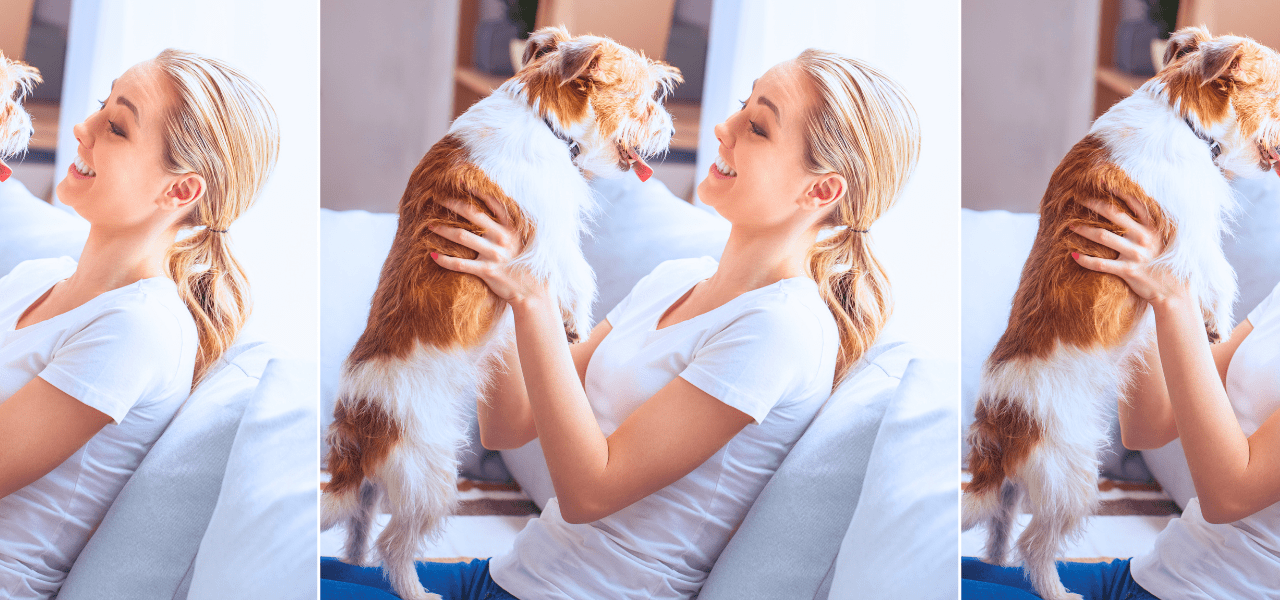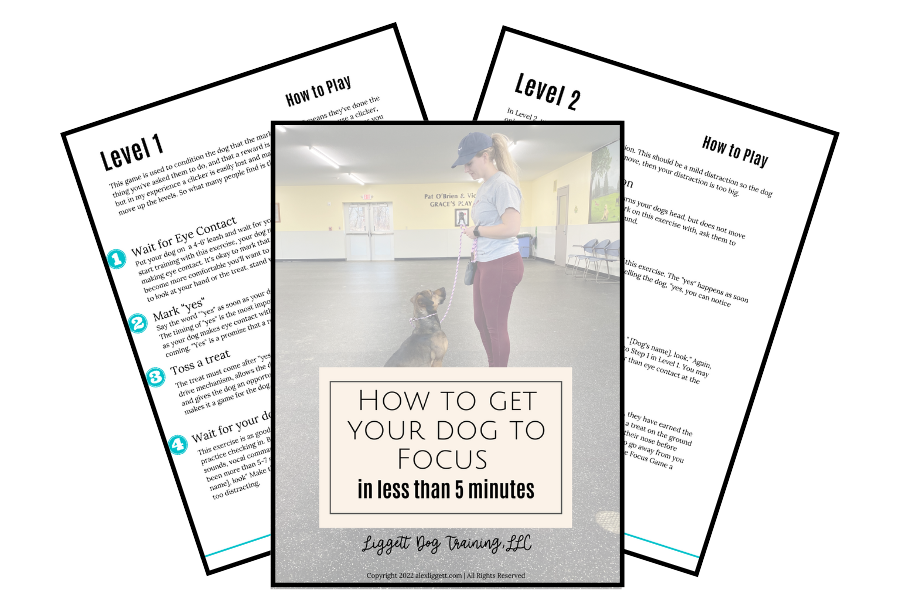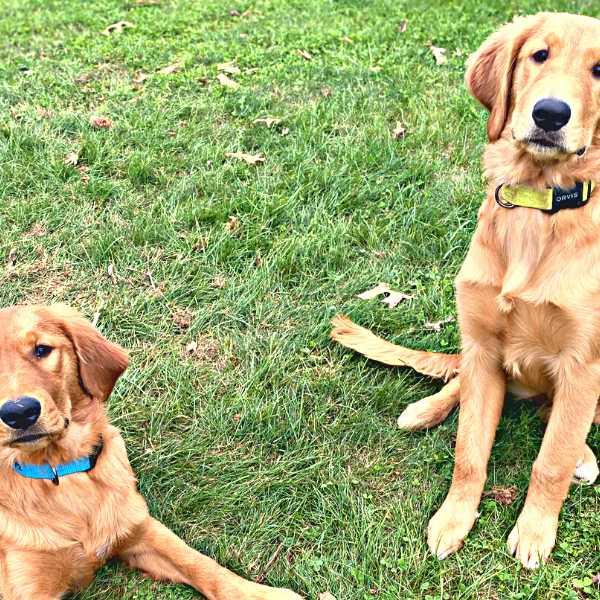
If you have a clingy dog who's attached to you like velcro, this article is for you!
As a dog trainer, I hear dog owners describe their clingy dog (or more affectionately known as a velcro dog) with a few phrases:
"I can't go anywhere without him getting up and getting excited."
"He's always right there and up my butt!
"I'm going to trip on him"
"He has no sense of personal space."
If this sounds like your dog, it's time to start addressing some of these behaviors. And- it's easier than you think!
In this article I'll teach you why some dogs become clingy and 9 of the best hacks for help you and your dog cut the cord and keep the peace.

Clingy Dog
Clingy Dog Meaning
You and your dog should feel comfortable around each other- and without each other! Your dog should be able to lay on the floor, in their crate or in a different room comfortably.
If you or your dog feel like there's anxiety surrounding each other's presence (or lack of presence) you may have a clingy dog.
This is absolutely something you can change about your dog! First, we'll discuss the reason your dog may be acting this way.
Clingy Dog Breeds
1. Genetics
Genetics doesn't mean that your dog can't be helped! In fact, if your dog tends to have a more attached personality style, your dog will be happy that you're investing into learning how to help them!
In my work as a trainer, I have seen all different breeds of dogs exhibit clingy behavior. Unfortunately, there are just some bad breeders out there, and good temperament isn't always the priority when deciding to breed.
It's not necessarily about the breed of the dog, as it is the quality of the parents' temperaments that play into this.
2. Other dogs in the house
Separation anxiety dog
3. History
Your dog's history before you brought them to your house could have some influence on their behavior.
Especially if you have a rescue dog that you don't have a lot of history on, you may not understand all of the triggers or worries that they have.
Related: 3 Tips for Shelter Dog Training for the First 3 Weeks
Be careful: You can speculate until you are blue in the face about why your dog is acting the way it's acting.
The most important thing is to treat your dog fairly now. Dogs let go of things so much quicker and easier than people do. So, don't hold onto negative feelings longer than your dog does.
Your dog is ready to move on and be happy and comfortable, they're just waiting on you to teach them how!
4. Your behavior
Ever hear that saying about "your dog is a mirror"? Your feelings could absolutely influence your dog's feelings.
If you are feeling nervous or worried about your dog's sense of well being, they will be worried, too and start making decisions for themselves, or for the both of you!
Related: 10 Taboo Ideas on How to Be a Good Dog Owner
This is how we get dogs who become protective of owners or who try to run away when they get nervous. In other words, if you are worried, you are not leading your dog.
This is especially true for a dog who is sensitive to emotional change from a person.
Signs of a Clingy Dog
5. Inability for your dog to self sooth
No matter your dog's age, your dog may not have learned to be on their own. This is especially true with dogs who have owners who work from home.
In these cases, they aren't separated from their person very often and therefore don't have to learn to be by themselves.
Even if it's not a person, your dog may have become attached to another dog, littermate, or even an animal of a different species!
6. Lack of stability in routine
Some dogs are very tolerant in their ability to navigate an ever changing routine, like dogs who live in camper vans.
In contrast, some dogs do not adjust that well. If there isn't structure in their routine, they may feel clingy towards the person who takes care of them.
They might act on these feelings in a way that does not facilitate trust and confidence.
It's important for a dog like this for you to create structure and routine which will increase their trust in you.
Now, let's talk about some tips to help your clingy dog!
How to Prevent a Clingy Dog
1. Stop making eye contact
Eye contact can be rewarding to your dog. So they may continue to do obnoxious things because you are encouraging it by looking at them.
Follow the rules "No talk. No touch. No eye contact" when your dog is doing something you don't want them to do.
A lot of the reason your dog is clingy is because they need something about you (space, affection, attention, sound) in order to emotionally regulate themselves.
2. Grab yourself a long line
When I come across a velcro dog in training, one of the first things I do is a long line lesson with the owner.
Related: 2 Easy Dog Long Leash Training Exercises to Improve Recall
A long line is an easy way for your dog to start gaining reward being away from you. Long lines can help your dog start to engage with other smells and things around them that aren't the person they are attached to.
Plus, as the owner, you get to practice leading the dog and not worrying about them. A dog learns how to be a dog on a long line instead of just being your shadow.
3. Crate train
If your dog isn't already crate trained, this can be a super useful tool in teaching them how to be comfy on their own.
Related: Crate Training a Rescue Dog | 5 Tips for Teaching Your Dog to Love the Crate
If your dog is already crate trained, make sure you can put the dog in their crate when you are home and when you are away. They should be able to sleep in their crate if needed.
If you have a dog older than 3-4 years old, it may be more difficult to crate train, not impossible though! There are lots of factors that play into training an older dog, but it's not impossible to teach them a new lifestyle!
Dog's are resilient and will follow your lead if your building a good, trusting relationship with them!
My dog constantly wants my attention
4. Stop celebrating everything.
If everything is a party for your dog, it's going to take them more and more effort to praise them. This can lead to them escalating their baseline "normal" to feel more and more excitable.
Making things a little more boring and less exciting is one of the best ways to help your dog emotionally regulate themselves.
This means, stop touching, talking or looking at your dog, unless you are actively praising them for something that they did. (Remember no talk, no touch, no eye contact)
Related: Dog Has Anxiety | 10+ Tips to Help Your Dog Feel Less Anxious
Now, I don't mean to tell you not to pet your dog, but you should be aware of the emotional state your dog is in when you're giving them eye contact, touch, or verbal connection.
Your dog should be able to calmly accept a slow pet from the shoulders to the hips (think like a massage pet), without it exciting them and encouraging them to become more elevated in their mood.
If they can't, we need to bring our body language down and create more calmness to lead them through decision making.
5. Create calmness with eye contact.
I know I just said not to look at your dogs eyeballs, but if you have something they want, this is a great time to teach them how to say their please and thank you.
Teaching a dog to give calm quiet eye contact when they are asking for something is a great way to teach them you are the provider of important things (like food, treats, walks, doorways, toys etc.).
Think of this like a check point before enjoying whatever reward the dog is asking for.
A great place to start with teach your dog this is the "Yes Game". Learn how to play here:
Velcro Dog
6. Do more leash work
Leash work is always important because it helps your dog understand the dynamic in the relationship. The leash can be a tool that helps your dog build up their confidence to do things on their own.
Leash work can teach a dog to hold their own space, so they aren't constantly leaning up against you or relying on you for support.
Related: How to Use a Slip Leash
Building up a dog's confidence comes from helping them do things on their own, rather than you doing things for them.
For example, leading them into the crate, making them walk down the stairs, helping them do "scary" things safely (like getting on the playground, jumping up on a bench etc), and guiding them to where they should be.
7. Use the "First Day of Preschool" analogy to help your mindset
If you are about to drop your kiddo off for the first day of school (or imagine your first day of school), how would you want your parent to act?
Do you want your parent to say, "Hey, this is going to be a big day. It'll be scary. There are gonna be lots of people you don't know, and I don't know if you'll make friends or not. I am not sure what you should do all day, but hopefully you won't get bullied, sit alone at lunch or trip in the hallway. Hmm.. I don't know if I should leave you here.."
Or
Hey kiddo, I know you're feeling a lot of things, but I trust these people to take care of you all day. You'll make lots of friends and I"ll be back to pick you up at 3. Until then, have so much fun!"
It's so much easier to trust and follow the parent in the second scenario, because that parent is leading with confidence and has done their homework to make sure they can be confident.
Overall, it's your job to show your dog what you want them to do and how you want them to behave!
Still wondering how to get started with your dog? I'd love to help! Schedule a consult now to discuss a custom plan for you and your dog!






